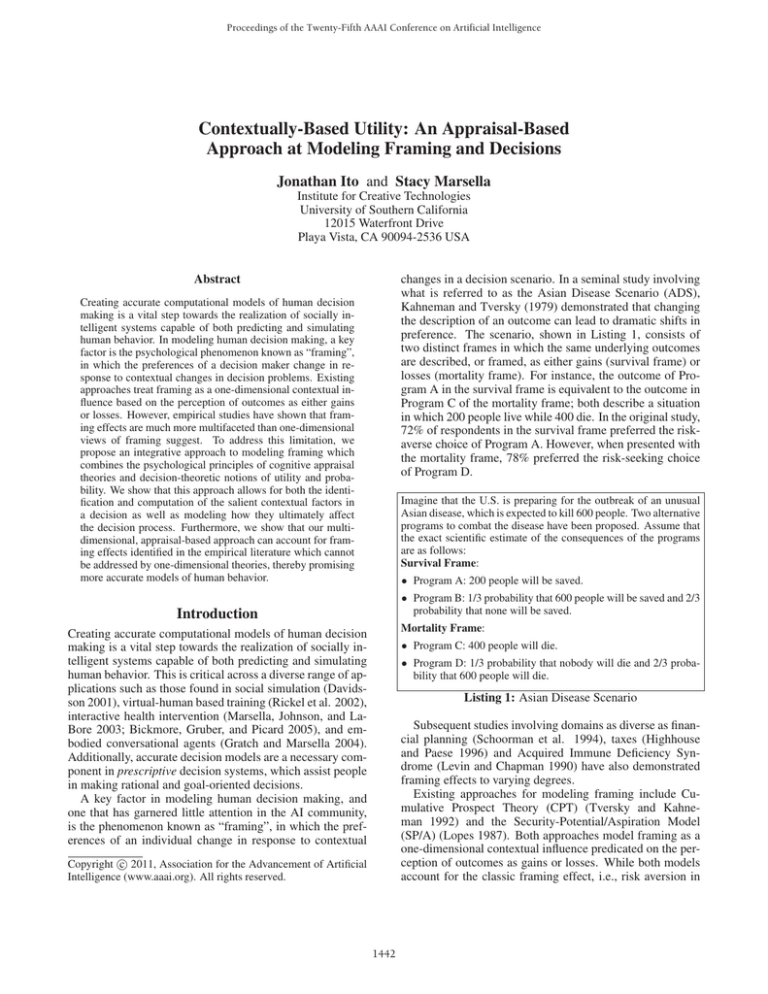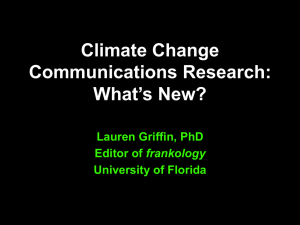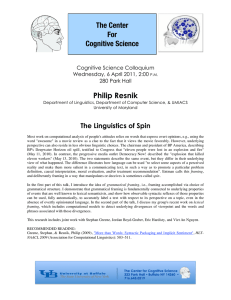
Proceedings of the Twenty-Fifth AAAI Conference on Artificial Intelligence
Contextually-Based Utility: An Appraisal-Based
Approach at Modeling Framing and Decisions
Jonathan Ito and Stacy Marsella
Institute for Creative Technologies
University of Southern California
12015 Waterfront Drive
Playa Vista, CA 90094-2536 USA
changes in a decision scenario. In a seminal study involving
what is referred to as the Asian Disease Scenario (ADS),
Kahneman and Tversky (1979) demonstrated that changing
the description of an outcome can lead to dramatic shifts in
preference. The scenario, shown in Listing 1, consists of
two distinct frames in which the same underlying outcomes
are described, or framed, as either gains (survival frame) or
losses (mortality frame). For instance, the outcome of Program A in the survival frame is equivalent to the outcome in
Program C of the mortality frame; both describe a situation
in which 200 people live while 400 die. In the original study,
72% of respondents in the survival frame preferred the riskaverse choice of Program A. However, when presented with
the mortality frame, 78% preferred the risk-seeking choice
of Program D.
Abstract
Creating accurate computational models of human decision
making is a vital step towards the realization of socially intelligent systems capable of both predicting and simulating
human behavior. In modeling human decision making, a key
factor is the psychological phenomenon known as “framing”,
in which the preferences of a decision maker change in response to contextual changes in decision problems. Existing
approaches treat framing as a one-dimensional contextual influence based on the perception of outcomes as either gains
or losses. However, empirical studies have shown that framing effects are much more multifaceted than one-dimensional
views of framing suggest. To address this limitation, we
propose an integrative approach to modeling framing which
combines the psychological principles of cognitive appraisal
theories and decision-theoretic notions of utility and probability. We show that this approach allows for both the identification and computation of the salient contextual factors in
a decision as well as modeling how they ultimately affect
the decision process. Furthermore, we show that our multidimensional, appraisal-based approach can account for framing effects identified in the empirical literature which cannot
be addressed by one-dimensional theories, thereby promising
more accurate models of human behavior.
Imagine that the U.S. is preparing for the outbreak of an unusual
Asian disease, which is expected to kill 600 people. Two alternative
programs to combat the disease have been proposed. Assume that
the exact scientific estimate of the consequences of the programs
are as follows:
Survival Frame:
• Program A: 200 people will be saved.
• Program B: 1/3 probability that 600 people will be saved and 2/3
probability that none will be saved.
Introduction
Mortality Frame:
Creating accurate computational models of human decision
making is a vital step towards the realization of socially intelligent systems capable of both predicting and simulating
human behavior. This is critical across a diverse range of applications such as those found in social simulation (Davidsson 2001), virtual-human based training (Rickel et al. 2002),
interactive health intervention (Marsella, Johnson, and LaBore 2003; Bickmore, Gruber, and Picard 2005), and embodied conversational agents (Gratch and Marsella 2004).
Additionally, accurate decision models are a necessary component in prescriptive decision systems, which assist people
in making rational and goal-oriented decisions.
A key factor in modeling human decision making, and
one that has garnered little attention in the AI community,
is the phenomenon known as “framing”, in which the preferences of an individual change in response to contextual
• Program C: 400 people will die.
• Program D: 1/3 probability that nobody will die and 2/3 probability that 600 people will die.
Listing 1: Asian Disease Scenario
Subsequent studies involving domains as diverse as financial planning (Schoorman et al. 1994), taxes (Highhouse
and Paese 1996) and Acquired Immune Deficiency Syndrome (Levin and Chapman 1990) have also demonstrated
framing effects to varying degrees.
Existing approaches for modeling framing include Cumulative Prospect Theory (CPT) (Tversky and Kahneman 1992) and the Security-Potential/Aspiration Model
(SP/A) (Lopes 1987). Both approaches model framing as a
one-dimensional contextual influence predicated on the perception of outcomes as gains or losses. While both models
account for the classic framing effect, i.e., risk aversion in
c 2011, Association for the Advancement of Artificial
Copyright Intelligence (www.aaai.org). All rights reserved.
1442
gains and risk seeking in losses, numerous empirical studies
within the framing literature have shown a great deal of variance and inconsistency in the classic framing effect which
suggests that a one-dimensional view of framing is descriptively incomplete (Schneider 1992; Bohm and Lind 1992;
Fagley and Miller 1987; Fagley and Kruger 1986).
In particular, one-dimensional approaches such as CPT
and SP/A have difficulty accounting for the moderating effects on framing brought about by providing choice rationale and the resistance to framing evinced by expert decision
makers.
In this work, we propose a framework for decision making
under risk which is descriptively flexible enough to model a
wide range of framing effects while remaining intuitive and
easily operationalizable. Specifically, we show that by employing psychological principles of cognitive appraisal we
can identify, extract, and compute the salient contextual aspects of a given decision scenario in a largely automated
manner. This appraisal information can then be used to inform a weighted utility function resulting in a decision process which is descriptively more accurate than existing theories.
k=9
dimsens (t, r, 9)
1
r=0
0.5
r=
1
4
r=
0
1
2
r=
-0.5
3
4
r=1
-1
0
0.2
0.4
0.6
t
0.8
1
0.8
1
(a) Varying reference point
r=
1
2
dimsens t, 12 , k
1
Approach
Our approach in creating a contextually-based, descriptive,
decision framework consists of two primary components:
the computational appraisal of decision outcomes and a decision evaluation function which incorporates the appraisal
information.
0.5
0
k=2
k=5
k = 10
-0.5
-1
0
0.2
Cognitive Appraisal of Outcomes
0.4
t
0.6
(b) Varying sensitivity
The process of cognitive appraisal, as defined in Appraisal
Theory, is an evaluation of personal significance over several
dimensions regarding an individual’s relationship with herself, the environment, and others by which emotions are differentiated and elicited for a given stimulus (Arnold 1960;
Lazarus 1991). It is precisely this assessment of personal
significance, with respect to the environment of the decision
maker, which provides us with a rich discretization of the
key contextual factors, or situational variables, involved in a
decision.
In this work, computational appraisal is defined as a function of diminishing sensitivity evaluated with respect to
some reference point. This definition represents both the
tendency of emotional habituation, in which continually increasing affect loses poignancy, and the notion that emotions
and appraisals are elicited not by the outcomes themselves
but by the changes which accompany them (Frijda 2007).
This suggests an S-shaped function in which the reference
point serves as the point of inflection. Therefore, a logistic function is employed to model diminishing sensitivity,
which forms the computational basis of appraisal, shown
in (1), in which the impact of t diminishes as it moves further from the reference point r. Additionally, the constant k,
where k ≥ 1, controls the degree of diminishing sensitivity.
The result of this function is a real value between −1 and 1
such that positive values correspond to positive appraisals,
e.g., appraisals of pleasantness, and negative values corre-
Figure 1: Diminishing Sensitivity Function Plots
spond to negative appraisals, e.g., appraisals of unpleasantness. Sample plots of the diminishing sensitivity function
are shown in Figures 1(a) and 1(b) in which both the reference point and the sensitivity, k, are respectively varied.
dimsens (t, r, k) =
2
−1
1.0 + exp (−k (t − r))
(1)
In this work, we present three concrete appraisal functions defined over outcomes: pleasantness, goal congruence,
and control. These three dimensions are chosen both because they are widely represented in the appraisal literature and can also be directly linked to notions of probability
and value, both of which are highly pertinent in decisiontheoretic domains.
It is important to note that our goal in this work is not
to implement a full computational model of appraisal, as
many promising implementations already exist (Gratch and
Marsella 2004; Aylett, Dias, and Paiva 2006; Dias and Paiva
2005; Si, Marsella, and Pynadath 2010). Rather, we seek
to leverage the principles underlying cognitive appraisal to
model the effect of framing on decision processes. More-
1443
over, while the three dimensions represented in our framework comprise only a subset of the appraisal dimensions
found in the literature, they provide a foundation on which
to build a decision function.
In what follows, a decision scenario is represented using a
standard decision-theoretic representation. A scenario consists of n distinct alternatives, in which the ith alternative
is labeled xi . Each alternative results in one of ni possible
outcomes, in which the jth outcome is denoted as outcome
xi,j . The probability of obtaining outcome xi,j , when alternative xi is chosen, is given by the probability function
p (xi,j ). Additionally, the associated value of outcome xi,j
is v (xi,j ) and is generally encoded directly from the numerical description of an outcome, e.g., amount of money won,
number of lives lost.
Control Control is a measure of the degree of agency and
influence that a decision maker has in a scenario. It is
conceptualized as both a form of agency (Roseman 1984;
Smith and Ellsworth 1985) and as a critical component in
coping potential (Smith and Lazarus 1990; Scherer 1982).
Control is an evaluation of decumulative probability made
with respect to some expectation of control (ec) as seen
in (4). The decumulative aspect of control, shown in (5),
is the total probability of achieving an outcome as good as
xi,j , in which outcomes are ordered from worst to best by
value. This corresponds to the intuition that even a highly
uncertain outcome, i.e., an outcome with a very low probability of occurrence, can be perceived as highly controllable
if the other alternate outcomes are even more preferred. In
other words, control is implemented not as a function of likelihood over the occurrence of a singular outcome but rather
as a function of likelihood over the achievement of a certain
value threshold.
Pleasantness Pleasantness is the intrinsic attractiveness or
unattractiveness of an outcome. Appraisals of pleasantness
play a central role in many predominant structural theories of cognitive appraisal (Roseman 1984; Scherer 1982;
Smith and Ellsworth 1985; Ortony, Clore, and Collins 1990).
Pleasantness is an evaluation of value made with respect to
the status quo (sq) as in (2).
ctrl (xi,j ) = dimsens (d (xi,j ) , ec, k)
ni
p (xi,k )
d (xi,j ) =
(4)
(5)
k=j
pleas (xi,j ) = dimsens (v (xi,j ) , sq, k)
The expectation of control establishes a reference point by
which it is judged whether outcomes are controllable or uncontrollable. While the expectation of control is certainly
influenced by situational variables such as the manner in
which the uncertainty in a scenario is described, it is also
subject to personal and individual factors such as locus of
control (Rotter 1966). The concept of locus of control distinguishes between two sources of control: internal and external. Internals tend to believe that they control their own
destiny and that outcomes are largely determined by their
efforts which is suggestive of a lower expectation of control.
That is, outcomes need only exceed a fairly low threshold
of likelihood in order to be perceived as controllable. Externals, on the other hand, tend to attribute successes or failures
to external forces such as nature, destiny, and other agents
which is suggestive of a higher expectation of control.
(2)
The status quo serves as the reference point differentiating pleasant from unpleasant outcomes. In other words, outcomes more preferred than the status quo are appraised as
pleasant, whereas less-preferred outcomes are perceived as
unpleasant. The status quo itself is the state resulting in no
change of current state for the decision-maker. In many decision scenarios, an explicit status quo is not provided. Oftentimes, the most natural location for it, and which is usually implied by convention, is the state associated with the
0-value, e.g., 0 lives lost, 0 dollars gained.
Goal Congruence Goal congruence is the degree to which
an outcome fulfills the adopted goals of the decision maker
which are heavily influenced by standards, expectations,
and responsibilities. Goal congruence, like pleasantness, is
well represented in the appraisal literature (Scherer 1982;
Roseman 1984; Smith and Lazarus 1990). We represent goal
congruence as an evaluation of value made with respect to
the aspiration outcome (ao) as in (3).
gc (xi,j ) = dimsens (v (xi,j ) , ao, k)
Contextually-Based Utility (CBU) Decision
Evaluation
The second component in our approach to modeling
contextually-based decision making is the implementation
of a decision function over the alternatives available in a decision.
The CBU function evaluates an alternative, xi , and maps
it to a real-value such that xi is preferred at least as much
as alternative xj if and only if CBU (xi ) ≥ CBU (xj ). The
CBU function takes the form of a standard decumulativelyweighted utility function, also commonly referred to as a
rank-dependent utility model (Quiggin 1982); it is comprised of both a weighting component, w, and a utility function, u, as in (6) in which outcomes are ordered from worst
to best. The decumulative component, d (xi,j ), is the total
probability that an outcome as good as xi,j will be obtained
and is defined identically to (5).
(3)
The aspiration outcome is the outcome which the decision maker aspires to and represents her adopted expectations, standards, morals, and obligations. Outcomes more
preferred than the aspiration outcome are said to be congruent with the goals of the decision maker whereas lesspreferred outcomes are incongruent. It can be argued that a
rational location for the aspiration outcome is the maximum
expected value of the scenario. However, as noted earlier,
the imposition of external standards and expectations, even
when self-imposed, may influence the aspiration outcome.
1444
CBU (xi ) =
ni
Status Quo
Aspiration
Outcome
Expectation
of Control
α
w (d (xi,j )) (u (xi,j ) − u (xi,j−1 )) (6)
j=1
The decumulative form is employed to allow for the
variable weighting of outcomes, such as either an optimistic over-weighting of desirable outcomes or a pessimistic
over-weighting of undesirable outcomes, while preserving
stochastic dominance. Stochastic dominance, stated simply,
is a highly desirable decision-theoretic principle asserting
that an alternative xi should be preferred at least as much as
alternative xj if all outcomes of xi are preferred at least as
much as the outcomes of xj .
In what follows, we show how the various dimensions of
our previously defined appraisal process relate to the weighting and utility components of the CBU function. Specifically, we show that appraisals of control inform the weighting component while appraisals of pleasantness and goal
congruence form a multi-attribute utility function.
Mortality Frame
0 die
Normal dist. centered at 400 die
Normal dist. centered at 0.5
See Figure 2
Sure-thing preference
Table 1: Encoding for Asian Disease Scenario
0.7
0.6
0.5
0.4
survival frame
mortality frame
0.3
0.2
0
0.6
0.8
1
α
Figure 2: Asian Disease Scenario Framing using CBU
Control as a Decision Weight The decision-weighting
function, a function of probability and likelihood, represents
the intensity and relative importance of a particular outcome.
Note that both our implementation of control, shown in (4),
and the weighting function w (xi,j ) are defined as functions
of decumulative probability. Therefore, we use the previously defined appraisal of control to inform the weighting
function.
The full control-based decumulative-weighting function,
w, is given in (7) in which the weighting function is the appraisal of control normalized such that its range is between
0 and 1.
0.2
0.4
Classic Framing Effect
The Asian Disease Scenario (ADS), originally introduced by
Kahneman and Tversky (1979), still remains one of the most
prominent examples of the classic framing effect and is presented in its entirety in Listing 1. The original experiments
demonstrated that decision makers are generally risk averse
in the domain of gains (survival frame) and risk seeking in
the domain of losses (mortality frame).
The decision-theoretic representation of both the survival
and mortality frames is straightforward. Probabilities are
described explicitly and the values of outcomes are encoded
as the number of lives saved in the survival frame, e.g., “200
saved” is 200, and a negative value for the number of lives
lost in the mortality frame, e.g., “600 die” is −600.
To model the scenario using CBU, we additionally specify the CBU-related variables as shown in Table 1. The ADS
leaves several contextual variables underspecified with respect to our framework. Therefore, we model the distribution of the aspiration outcome as a normal distribution where
the mean is the arguably rational expected value of the scenario. Specifically, this is the value associated with “200
saved” and “400 die” in the survival and mortality frames
respectively. Additionally, we model the expectation of control as a normal distribution with a mean of 12 which follows from empirical studies on expectations of control (Rotter 1975). Lastly, we interpret α, which controls the relative
weight given to considerations of pleasantness and goal congruence, as being highly situational and is therefore treated
as an independent variable. The plot of the resulting CBU
function is shown in Figure 2 in which the x-axis models
variations in α, and the y-axis corresponds to the relative
strength of preference for the sure-thing alternative. The
shaded area of the plot is the region in which the relative
preference for the sure-thing choice exceeds that of the risky
option.
1
1
ctrl (xi,j ) +
(7)
2
2
Pleasantness and Goal Congruence as a Multi-Attribute
Utility Function The utility function, which maps an outcome to a real value, is representative of the “goodness” of
an outcome and is independent of considerations of weight
or probability. We therefore employ the appraisals of pleasantness and goal congruence, both based on evaluations of
value, to inform the utility function.
We represent utility as a multi-attribute utility function
which models the trade-off between considerations of pleasantness and goal congruence as in (8), where 0 ≤ α ≤ 1
and in which α and 1 − α are the relative weights given to
considerations of pleasantness and goal congruence respectively.
w (xi,j ) =
u (xi,j ) = α pleas (xi,j ) + (1 − α) gc (xi,j )
Survival Frame
0 saved
Normal dist. centered at 200 saved
Normal dist. centered at 0.5
See Figure 2
(8)
CBU and Decision Framing
We now show that our CBU framework can model a wide
range of framing effects not previously accounted for in
other computational models. Specifically, we show that
CBU can account for not only traditional framing effects but
also the impact of providing choice rationale and the role of
domain expertise.
1445
The plot shows that the CBU framework does predict riskaverse behavior in the survival frame. However, in the mortality frame, risk-seeking behavior is not evidenced until the
value of α, representative of the relative weight given to considerations of pleasantness, is sufficiently high. The consistency of preference in the survival frame is due to the
proximity of the status quo and aspiration outcome which
lead to similar appraisals of pleasantness and goal congruence and ultimately a risk-averse preference. Alternatively,
in the mortality frame the status quo and aspiration outcome
are highly differentiated which lead to conflicting appraisals
and a subsequently greater variance in preference depending
on the value of α. These findings echo the empirical work
of Schneider (1992) showing that while preferences for risk
aversion in positive frames are robust, preferences for negatively framed options, while generally risk seeking, are weak
and inconsistent.
Sure-thing preference
0.7
0.6
0.5
0.4
survival
mortality
survival (rationale)
mortality (rationale)
0.3
0.2
0
0.2
0.4
0.6
0.8
1
α
Figure 3: ADS Rationale Framing in CBU
Domain Expertise
Another framing phenomena is the resistance to framing effects shown by experts. In a study involving school psychologists and a student dropout scenario similar to the ADS,
where outcomes are described as either the number of children who stay in school (positive framing) or the number that drop out (negative framing), psychologists demonstrated highly consistent risk-averse preferences when compared to control subjects (Fagley and Kruger 1986).
Both PT and SP/A are unable to account for the effect of
expertise. Again, it is due to their one-dimensional view of
contextual influence. And since there is no clear link between the perception of outcomes as gains or losses and decision expertise, both PT and SP/A theory are silent regarding its effect on framing.
Within the CBU model we represent expertise in a decision domain as an emphasis on considerations of goal congruence as well as differences in aspiration outcomes. These
differences in aspiration are representative of the prior expectations expert decision makers possess and which subsequently influence other decisions based in their respective areas of expertise. In this sense, we model expertise
in a manner prescribed by the Probabilistic Mental Model
(PMM) Theory (Gigerenzer, Hoffrage, and Kleinbölting
1991), which posits that decision makers often make decisions based on information constructed from past, non-local,
experience and knowledge. For instance, in the study involving school psychologists, we may assume that the adopted
expectations of the psychologists are much lower than the
expected value of the drop-out scenario 2 .
To model decision expertise, we employ an encoding for
the outcomes and CBU-related variables similarly to the
ADS scenario as in Table 1. Additionally, we use the modified utility function, û (xi,j ), in (9) to emphasize considerations of goal congruence and either a high (normal distribution centered at “400 stay in school”/“200 dropout”) or low
(normal distribution centered at “100 stay in school”/“500
dropout”) aspiration outcome. The plot for both positive and
negative frames in both conditions is shown in Figure 4.
Choice Rationale
When decision makers must provide a justification for their
decisions, framing effects are reduced. In a series of experiments conducted with university students involving the
ADS, subjects were informed they would be providing
choice rationale. While results in the survival frame were
consistent with classical framing effects, i.e., majority riskaverse preferences, preferences in the mortality frame were
not significantly risk seeking (Fagley and Miller 1987).
Neither CPT or SP/A Theory can explicitly account for
this effect due to their one-dimensional view of framing.
In both theories, the parameters controlling the behavior
of the decision evaluation functions are contingent only on
whether an outcome is perceived as a gain or a loss.
Within the CBU framework, we model the provision of
choice rationale as an emphasis on considerations of goal
congruence. Specifically, it is modeled as a reduction in α,
which corresponds to a reduction in the weight associated
with considerations of pleasantness and an increase in considerations of goal congruence. Therefore, a modified utility
function, û (xi,j ), as seen in (9) is employed in these situations.
8
8
û (xi,j ) =
α pleas (xi,j ) + 1 − α gc (xi,j ) (9)
10
10
In encoding this variation of the ADS we employ the original encoding of both the outcomes and the CBU-related
variables as in Table 1. The plot of the rationale-adjusted
frames and the standard frames is shown in Figure 3 1 .
The plot shows that while an enhanced sense of goal congruence has no effect in the survival frame, it does play a
moderating role in the mortality frame which is consistent
with the original study by Fagley and Miller (1987). Additionally, our model predicts that this moderating effect is
stronger when considerations of pleasantness are sufficiently
high - something which we hope to explore in future work.
2
Data from the U.S. Department of Education shows that dropout rates in the United States have declined only about 3.5% from
1972 to 1992 (McMillen 1993) which suggests that an expectation
of preventing 13 of students from dropping out is overly optimistic
1
Plots for the survival frame and the rationale-adjusted survival
frame are essentially identical and therefore overlap
1446
Aylett, R.; Dias, J.; and Paiva, A. 2006. An affectivelydriven planner for synthetic characters. Proceedings of
ICAPS 2006.
Bickmore, T.; Gruber, A.; and Picard, R. 2005. Establishing
the computer–patient working alliance in automated health
behavior change interventions. Patient Education and Counseling 59(1):21–30.
Bohm, P., and Lind, H. 1992. A note on the robustness of a
classical framing result* 1. Journal of Economic Psychology
13(2):355–361.
Davidsson, P. 2001. Multi agent based simulation: beyond
social simulation. Multi-Agent-Based Simulation 141–155.
Dias, J., and Paiva, A. 2005. Feeling and reasoning: A
computational model for emotional characters. Progress in
Artificial Intelligence 127–140.
Fagley, N., and Kruger, L. 1986. Framing effects on the program choices of school psychologists. In Annual Meeting of
the American Psychological Association, Los Angeles, CA.
Fagley, N., and Miller, P. 1987. The effects of decision framing on choice of risky vs certain options. Organizational
Behavior and Human Decision Processes 39(2):264–277.
Frijda, N. 2007. The laws of emotion. Lawrence Erlbaum
Associates.
Gigerenzer, G.; Hoffrage, U.; and Kleinbölting, H. 1991.
Probabilistic mental models: A brunswikian theory of confidence. Psychological Review 98(4):506–528.
Gratch, J., and Marsella, S. 2004. A domain-independent
framework for modeling emotion. Cognitive Systems Research 5(4):269–306.
Highhouse, S., and Paese, P. 1996. Problem domain and
prospect frame: Choice under opportunity versus threat.
Personality and Social Psychology Bulletin 22(2):124.
Kahneman, D., and Tversky, A. 1979. Prospect theory: An
analysis of decision under risk. Econometrica 47(2):263–
291.
Lazarus, R. 1991. Emotion and adaptation. Oxford University Press, USA.
Levin, I., and Chapman, D. 1990. Risk taking, frame of reference, and characterization of victim groups in aids treatment decisions. Journal of Experimental Social Psychology
26(5):421–434.
Lopes, L. 1987. Between hope and fear: The psychology of risk. Advances in experimental social psychology
20(3):255–295.
Marsella, S.; Johnson, W.; and LaBore, C. 2003. Interactive pedagogical drama for health interventions. In Conference on Artificial Intelligence in Education, Sydney, Australia. Citeseer.
McMillen, M. 1993. Dropout rates in the united states:
1992.
Ortony, A.; Clore, G.; and Collins, A. 1990. The cognitive
structure of emotions. Cambridge Univ Pr.
Quiggin, J. 1982. A theory of anticipated utility. Journal of
Economic Behavior & Organization 3(4):323–343.
Sure-thing preference
0.6
0.5
positive (high AO)
negative (high AO)
positive (low AO)
negative (low AO)
0.4
0.3
0
0.2
0.4
0.6
0.8
1
α
Figure 4: Dropout Expertise Framing in CBU
The results show that lower prior expectations tend to
shift preferences for both frames towards risk aversion and
increase consistency of choice between frames. Alternatively, adopting higher expectations shifts preferences towards risk seeking and marginally increases choice consistency. This suggests that possessing prior expectations
which differ from the situational expected value may lead
to a reduction in the framing effect. Moreover, while this is
consistent with previous empirical research on expertise, our
model also implies that the “directionality” of prior expectations are important. Specifically, they play an integral role
in the overall risk preferences and the degree of choice consistency of the decision maker which has yet to be validated
in empirical studies.
Conclusion
Computational models of human decision making are becoming more important in a wider range of applications.
Therefore, it is vital that these models can account for a
broad range of human behavior while remaining readily implementable. One well-established hallmark of human decision behavior, typically problematic for theories of choice, is
the phenomenon of framing, by which the same underlying
problem described differently produces different results.
Existing approaches at modeling framing treat it as a onedimensional contextual influence and therefore lack the descriptive flexibility to account for a broad range of behavior.
Therefore, we have proposed a contextually-sensitive decision framework which integrates the psychological principles of cognitive appraisal with traditional decision-theoretic
approaches for modeling preferences. In particular, we have
shown that appraisals of pleasantness and goal congruence
can be used in a multi-attribute utility function while appraisals of control inform the weighting function.
Furthermore, by employing the CBU framework and using examples based on the classic Asian Disease Scenario
and a school dropout scenario, we show that our framework is descriptively flexible enough to account not only for
classical framing effects but also allow for the provision of
choice rationale and domain expertise.
References
Arnold, M. 1960. Emotion and personality. Columbia University Press New York.
1447
Rickel, J.; Marsella, S.; Gratch, J.; Hill, R.; Traum, D.; and
Swartout, W. 2002. Toward a new generation of virtual humans for interactive experiences. IEEE Intelligent Systems,
32–38.
Roseman, I. 1984. Cognitive determinants of emotion: A
structural theory. Review of Personality & Social Psychology
5:11–36.
Rotter, J. 1966. Generalized expectancies for internal versus
external control of reinforcement.
Rotter, J. 1975. Some problems and misconceptions related
to the construct of internal versus external control of reinforcement. Journal of consulting and clinical psychology
43(1):56–67.
Scherer, K. 1982. Emotion as a process: Function, origin
and regulation. Social Science Information 21(4-5):555.
Schneider, S. 1992. Framing and conflict: Aspiration level
contingency, the status quo, and current theories of risky
choice. Journal of Experimental Psychology: Learning,
Memory, and Cognition 18(5):1040–1057.
Schoorman, F.; Mayer, R.; Douglas, C.; and Hetrick, C.
1994. Escalation of commitment and the framing effect: An
empirical investigation. Journal of Applied Social Psychology 24(6):509–528.
Si, M.; Marsella, S.; and Pynadath, D. 2010. Modeling
appraisal in theory of mind reasoning. Autonomous Agents
and Multi-Agent Systems 20(1):14–31.
Smith, C., and Ellsworth, P. 1985. Patterns of cognitive
appraisal in emotion. Journal of personality and social psychology 48(4):813–838.
Smith, C., and Lazarus, R. 1990. Emotion and adaptation.
Handbook of personality: Theory and research 609–637.
Tversky, A., and Kahneman, D. 1992. Advances in prospect
theory: Cumulative representation of uncertainty. Journal of
Risk and uncertainty 5(4):297–323.
1448






